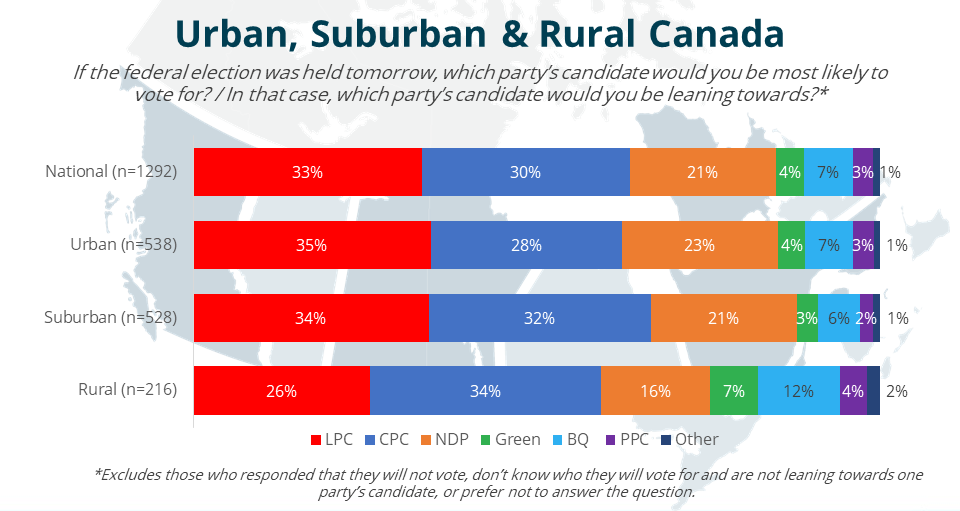Conservatives cut Liberal lead in half in first week
As if anyone needed a reminder, the first week of the campaign has provided more evidence that campaigns matter. The changes in popular vote are small, not even statistically significant, but at these levels, even small shifts are important if they are accurate. Liberal support went from 35% to 33% nationally among decided and leaning voters, while the Conservative support was 29% and is now measures at 30% and the NDP was 20% and is now 21%. Individually, none of these changes are significant, but cutting a lead from 6% to 3% is material if real. More so if it is part of a longer trend.
Turning to notable regional battles, our poll now has the NDP and Liberals tied at 32% in BC, a drop of 3% for the Liberals and a gain of two points for the NDP and a marked improvement from Election Day in 2019 for both parties, when they captured 26% and 24% of the vote. The Conservatives rose two points to 26%, which is still down from the 34% of support they garnered in the last election.
In Quebec, the numbers are basically unchanged with the Liberals in the lead holding at 37% and the Bloc Quebecois at 31%.
In Ontario, our poll shows the Liberals still leading with 37% support to the Conservatives’ 31%. When the campaign kicked off a week ago, the NDP were polling slightly better than they did in the last election, up 4 points to 21% and their share of Ontario voters has increased another three points to stand at 24% currently. That’s an impressive 7% higher than their share of 2019 votes in the province.

The race in the suburbs
Last week, we highlighted the large (11%) lead the Liberal Party enjoyed in vote-rich suburban Canada. In one week, the lead has basically disappeared, with Liberal support now at 34% and Conservatives at 32%.

Potential Shifting
Among decided and leaning voters, 70% can name a party that would be their second choice and the NDP is named far more often than any other party. More than one quarter (27%) of voters currently saying they would vote for another party say the NDP would be their second choice, far ahead of the Liberals at 15% and Greens (10%). At 6%, the CPC and PPC have identical proportions naming the party as their second choice.
The proportions of decided and leaning voters who name a second-choice party varies from party to party with the BQ (56%) and CPC (65%) having the fewest who name a second choice, while about three-quarters of NDP voters (75%) or LPC voters (73%) name a second party.
The directions they would go tell a story about the strategic possibilities for each party. While CPC voters are the least likely to name a second party, there is much division over where they would shift their support with 22% saying it would be LPC, and 15% each naming NDP or PPC.
In contrast, LPC voters show almost no inclination to name CPC as their second choice (2%), but a majority (56%) name the NDP.
Current NDP supporters, on the other hand, are divided over whether the LPC (31%) or the Green Party (28%) would be their second choice and 12% name the CPC.

This survey was sponsored by Earnscliffe Strategy Group and conducted by Leger using a random sampling of panelists from Leger’s proprietary online panel. The survey was conducted with 1,527 individuals from across Canada between August 20 and 22, 2021. The data was weighted to be reflective of the Canadian population by age, region, gender, education and mother tongue (QC only, FR vs non-FR) based on 2016 Census data. Since this survey was conducted using an online panel, no margin of error may be calculated.Earnscliffe follows the CRIC Public Opinion Research Standards and Disclosure Requirements that can be found here: https://canadianresearchinsightscouncil.ca/standards/
View the survey questionnaire | Download the full data tables

